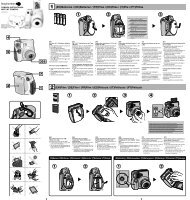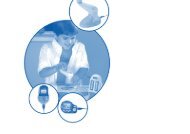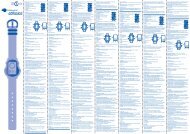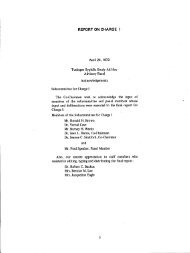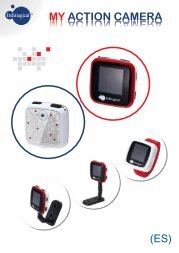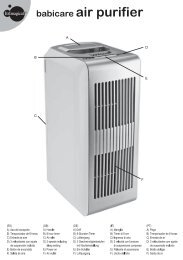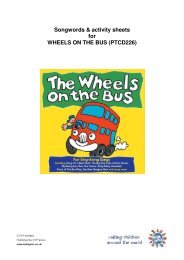bike in progress - Imaginarium
bike in progress - Imaginarium
bike in progress - Imaginarium
Create successful ePaper yourself
Turn your PDF publications into a flip-book with our unique Google optimized e-Paper software.
• More detailed <strong>in</strong>formation on how to mount the front<br />
brakes.<br />
Warn<strong>in</strong>g! It is possible for children to ignore this function,<br />
and the effects of the bicycle's removable brakes. Please,<br />
expla<strong>in</strong> to them how it works and the effects of the front<br />
brake, <strong>in</strong> order to avoid falls.<br />
– The front wheel brake can be mounted with a harmless<br />
brake lever for small children.<br />
– The brake lever gap can be adjusted to fit the size of the<br />
child's hand with an adjustment screw.<br />
– Please check the follow<strong>in</strong>g each time the child is go<strong>in</strong>g to<br />
ride the bicycle:<br />
– The brake lever must move easily.<br />
– The distance between the brake lever and the handlebar<br />
must be appropriate for the child's hand.<br />
– When turn<strong>in</strong>g the adjust<strong>in</strong>g screw clockwise, you reduce<br />
the distance between the brake lever and the handlebar<br />
grip. This distance is correct when the child is able to<br />
squeeze the brake with two f<strong>in</strong>gers, us<strong>in</strong>g normal<br />
pressure.<br />
Warn<strong>in</strong>g! It should not be possible to squeeze the brake<br />
lever without the brakes us<strong>in</strong>g their maximum strength.<br />
Make sure the brake works each time you adjust the<br />
distance between the lever and the handlebar grip. If<br />
necessary, adjust the brakes aga<strong>in</strong>.<br />
– If the effectiveness of the brake is reduced, adjust the<br />
brake aga<strong>in</strong> by follow<strong>in</strong>g the steps above.<br />
9. REAR WHEEL BRAKE:<br />
– The rear brake is <strong>in</strong>side the back rim bush<strong>in</strong>g and it is<br />
connected to the bicycle frame with a brake cam. It<br />
comes completely assembled.<br />
– The rear brake can only be used when the transmission<br />
assembly is <strong>in</strong> place.<br />
– The rear brake is activated by pedall<strong>in</strong>g backwards. This<br />
way the children are able to use their legs to exert<br />
sufficient force on the brake.<br />
– Once the transmission assembly is <strong>in</strong> place, ensure that<br />
the brake cam is properly fitted to the frame with the nut<br />
and the bolt.<br />
– The rear brake <strong>in</strong>side the back rim does not require any<br />
adjustments or modifications.<br />
Warn<strong>in</strong>g! If the brake cam is not properly attached to the<br />
frame, the brake will not work. The brake cam must be<br />
properly fitted to the frame. Please check that it is before<br />
each use.<br />
10. THE SADDLE:<br />
• Adjust<strong>in</strong>g saddle height:<br />
WITHOUT THE PEDAL SYSTEM MOUNTED (Tra<strong>in</strong><strong>in</strong>g<br />
Bicycle):<br />
– If the pedal system has not been mounted, the saddle<br />
will be at the correct height when the child's feet reach<br />
the floor without difficulty.<br />
Warn<strong>in</strong>g! Keep the saddle at a lower height until the child<br />
has got used to the bicycle.<br />
WITH THE PEDAL SYSTEM MOUNTED (Bicycle with<br />
pedals):<br />
– When the pedal system is mounted, the saddle will be at<br />
the correct height when the child's foot can rest<br />
comfortably on the pedal (at its lowest position).<br />
– The child's leg should be slightly bent.<br />
– Loosen the screw to adjust the height of the saddle.<br />
– Tighten the screw aga<strong>in</strong> to lock the saddle.<br />
– Once the pedal system is mounted, the saddle cannot be<br />
adjusted to its lowest position.<br />
– As the child grows up, you will have to adjust the saddle<br />
height periodically.<br />
Warn<strong>in</strong>g! Take <strong>in</strong>to account the tube's m<strong>in</strong>imum <strong>in</strong>sertion<br />
level, <strong>in</strong>dicated with “m<strong>in</strong>. <strong>in</strong>sertion”. If the m<strong>in</strong>imum level is<br />
not respected, the saddle tube could break and the child<br />
could fall.<br />
• Adjust<strong>in</strong>g the position and/or tilt of the saddle:<br />
1. Loosen the four hexagonal screws. It is not necessary to<br />
remove the protective devices.<br />
2. Place the saddle <strong>in</strong> the desired horizontal position.<br />
3. Tighten back the hexagonal screws.<br />
– These <strong>in</strong>structions are to help you adjust the saddle so<br />
that it is comfortable for the child.<br />
– It will be <strong>in</strong> the right position once the child is comfortable<br />
rid<strong>in</strong>g the bicycle.<br />
11. THE REFLECTORS:<br />
The bicycle <strong>in</strong>cludes two reflectors for the spokes, one front<br />
reflector and one rear reflector.<br />
You just have to align the front reflector and mount the rear<br />
reflector on the saddle's tube, which will only be possible if<br />
the saddle height is approximately 5 cm.<br />
1 Rear reflector mounted on the saddle tube.<br />
2 Align the front reflector as <strong>in</strong>dicated <strong>in</strong> the illustration<br />
below, loosen<strong>in</strong>g the screw and then tighten<strong>in</strong>g it aga<strong>in</strong>.<br />
12. THE PEDALS:<br />
– Mount the pedals before mount<strong>in</strong>g the pedal system.<br />
– If you mount the pedals at an angle, the lever thread will<br />
break.<br />
– Mount the pedal marked "R" <strong>in</strong> the right lever (next to the<br />
cha<strong>in</strong>) clockwise (right side thread).<br />
– Attach the pedal marked “L” on the right lever,<br />
counter-clockwise (left side thread).<br />
Warn<strong>in</strong>g! If a pedal is attached <strong>in</strong>correctly, it could come off<br />
as the child is rid<strong>in</strong>g the bicycle.<br />
13. PEDAL SYSTEM:<br />
The bicycle can be converted from a tra<strong>in</strong><strong>in</strong>g bicycle to a<br />
bicycle with pedals simply with the required tools and a<br />
m<strong>in</strong>imum of technical knowledge.<br />
Warn<strong>in</strong>g! If the pedal system and the cha<strong>in</strong> cover are not<br />
attached correctly, the child could fall and be <strong>in</strong>jured.<br />
Once the pedal system is mounted, the saddle cannot be<br />
adjusted to its lowest position.<br />
1. If the saddle is on the lowest position, you should raise it<br />
about 5 cm before mount<strong>in</strong>g the pedals.<br />
2. Prop the <strong>bike</strong> on the handlebar and saddle.<br />
3. Remove the plastic cover.<br />
4. Remove the screws from the base of the brakes.<br />
5. Loosen the nuts and remove the rear wheel from the<br />
bicycle frame.<br />
6. Introduce the pedal system axle <strong>in</strong> the frame support, so<br />
that the cha<strong>in</strong> rema<strong>in</strong>s on the left side.<br />
7. Adjust the pedal system with the nuts and bolts.<br />
Warn<strong>in</strong>g! Tighten the nuts and bolts correctly. The pedal<br />
system should not move at all.<br />
8. Remove the nut and the washer, and unscrew the<br />
protective cover of the rear gear.<br />
9. Place the cha<strong>in</strong> on the cha<strong>in</strong> gear and the rear gear, and<br />
put the rear wheel back on. Do not tighten the nuts yet.<br />
10. The cha<strong>in</strong> cover has two elements. Put the rear element<br />
and the guide between the frame and the oppos<strong>in</strong>g nut<br />
on the axle.<br />
11. Remove the cha<strong>in</strong> cover screw. Place the front element<br />
above the lever, over the cha<strong>in</strong> cover holder, and adjust it<br />
<strong>in</strong> three po<strong>in</strong>ts.<br />
12. Jo<strong>in</strong> the two cha<strong>in</strong> cover elements us<strong>in</strong>g the tabs and<br />
slots until you hear them click <strong>in</strong>to place. Do not force it,<br />
s<strong>in</strong>ce it could damage the cha<strong>in</strong> cover.<br />
13. Put the bicycle on its wheels aga<strong>in</strong> and adjust both cha<strong>in</strong><br />
cover elements with the screw that was removed<br />
previously.<br />
14. Adjust the brake holder back <strong>in</strong> the frame. Do not tighten<br />
the screw yet.<br />
15. Tighten the cha<strong>in</strong> by pull<strong>in</strong>g the rear wheel backwards.<br />
The cha<strong>in</strong> should be able to move about 10 mm up and<br />
down.<br />
16. Tighten the screws and make sure the cha<strong>in</strong> is properly<br />
tense, and that the rear wheel is well centred.<br />
17. Now tighten the screw to attach the brake holder to the<br />
bicycle's frame.<br />
14. BEFORE EACH USE:<br />
– Make sure that the front and rear brakes work correctly.<br />
– Make sure the saddle, handlebar and wheels are<br />
securely <strong>in</strong> place.<br />
– Also check the condition and pressure of the tyres.<br />
15. CARE:<br />
Clean the bicycle regularly with a wet cloth or a sponge.<br />
<strong>bike</strong> <strong>in</strong> <strong>progress</strong><br />
Avec ou sans pédales, c'est génial ! ce sera sa première<br />
bicyclette, celle avec laquelle il apprendra à rouler.<br />
MANUEL DE L'UTILISATEUR :<br />
Ce manuel de l'utilisateur contient toute l'<strong>in</strong>formation<br />
nécessaire pour utiliser cette bicyclette en toute sécurité,<br />
a<strong>in</strong>si que des <strong>in</strong>formations sur son entretien.<br />
Veuillez lire attentivement ces <strong>in</strong>structions avant d'utiliser la<br />
bicyclette pour la première fois. Ne laissez pas votre enfant<br />
l'utiliser avant que vous (père, mère ou tuteur) n'ayez lu et<br />
compris les spécifications de ce manuel.<br />
1. IMAGE GÉNÉRALE DE LA BICYCLETTE :<br />
La bicyclette est un produit de qualité, élaboré<br />
spécifiquement pour satisfaire les beso<strong>in</strong>s des plus jeunes.<br />
Les enfants âgés de plus de deux ans et demi peuvent<br />
l'utiliser comme bicyclette d'apprentissage dans la phase<br />
<strong>in</strong>itiale. Plus tard, elle peut être transformée en bicyclette<br />
<strong>in</strong>fantile pourvue de pédales.<br />
A B<br />
A) Bicyclette d'apprentissage<br />
B) Bicyclette avec pédales<br />
5 6<br />
Image générale<br />
14<br />
1<br />
13<br />
12<br />
2<br />
11<br />
1. Roue arrière<br />
2. Selle<br />
3. Sonnette<br />
4. Guidon<br />
5. Poignées de fre<strong>in</strong><br />
6. Fre<strong>in</strong> avant<br />
7. Roue avant<br />
8. Fourche<br />
9. Poignées<br />
10. Cadre<br />
11. Pédales<br />
12. Système de pédales<br />
13. Protection de la chaîne<br />
14. Chaîne<br />
2. CONTENU :<br />
10<br />
9<br />
3 4<br />
• 1 bicyclette (partiellement montée)<br />
• 1 roue avant<br />
• 1 outil à usage multiple<br />
• 2 réflecteurs pour radio (montés)<br />
• 1 réflecteur avant<br />
• 1 réflecteur arrière<br />
• 1 système de pédales avec vis de montage<br />
• 1 protecteur de chaîne<br />
• 1 chaîne<br />
• 2 pédales<br />
• 1 sonnette (montée)<br />
• 1 manuel d'utilisateur<br />
3. INFORMATION IMPORTANTE :<br />
• Comment vous et l'enfant devez utiliser la bicyclette ?<br />
Lorsque l'enfant dom<strong>in</strong>era le maniement de la bicyclette<br />
dans son mode apprentissage, vous pourrez la<br />
transformer en bicyclette <strong>in</strong>fantile en quelques m<strong>in</strong>utes et<br />
sans connaissances techniques particulières A<strong>in</strong>si,<br />
l'enfant entrera de manière naturelle dans le monde<br />
merveilleux du cyclisme et apprendra à garder l'équilibre.<br />
• Responsabilité des parents ou des tuteurs :<br />
Si la bicyclette est utilisée correctement, il n'y aura<br />
presque pas de danger quand l'enfant jouera avec elle.<br />
Toutefois, n'oubliez pas que la nature espiègle et<br />
joueuse de l'enfant peut produire des situations de<br />
risque imprévisibles. C'est pourquoi il faut montrer à<br />
l'enfant comment utiliser correctement la bicyclette et lui<br />
expliquer les éventuels dangers.<br />
• La sécurité de l'enfant :<br />
– Ne laissez pas votre enfant l'utiliser avant que vous<br />
(père, mère ou tuteur) n'ayez lu et compris les<br />
spécifications de ce manuel.<br />
– Le poids maximum supporté par la bicyclette est de 25<br />
kg.<br />
– Assurez-vous que l'enfant porte toujours un casque<br />
quand il utilise la bicyclette<br />
– Montrez à votre enfant comment utiliser la bicyclette en<br />
toute sécurité (garder l'équilibre, diriger et fre<strong>in</strong>er).<br />
Aidez-le jusqu'à ce qu'il puisse l'utiliser tout seul.<br />
– En cas de conditions atmosphériques adverses (par<br />
exemple pluie, neige ou gel), il n'est pas recommandé<br />
que l'enfant utilise la bicyclette à l'extérieur, car le sol<br />
serait glissant et il pourrait tomber et se faire mal. Ces<br />
conseils doivent également être suivis lorsqu'il circule ou<br />
fre<strong>in</strong>e trop brusquement sur des surfaces planes.<br />
– Elle doit toujours être utilisée sous la surveillance d'un<br />
adulte.<br />
– La bicyclette ne doit pas être utilisée dans des rues<br />
publiques.<br />
– Il faut ajouter des réflecteurs af<strong>in</strong> que l'enfant soit<br />
clairement visible.<br />
– Les enfants âgés de mo<strong>in</strong>s de deux ans et demi ne<br />
doivent pas utiliser la bicyclette.<br />
– L'enfant doit être capable de toucher le sol avec les deux<br />
pieds sans difficulté.<br />
– L'enfant doit porter des chaussures adéquates pour<br />
utiliser la bicyclette.<br />
– Vérifiez régulièrement que le fre<strong>in</strong> avant fonctionne<br />
5<br />
6<br />
7<br />
8




